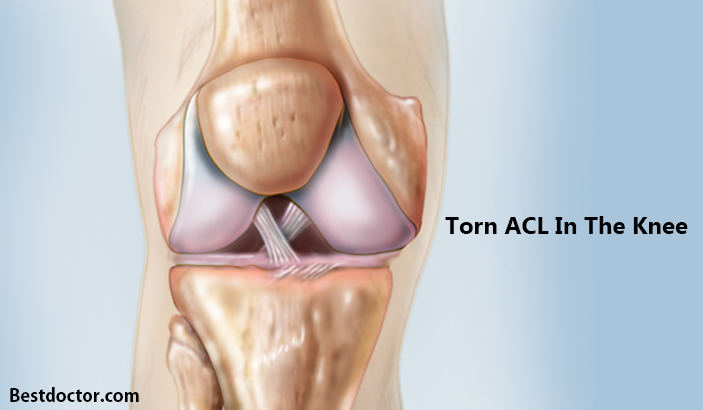What Is An ACL Injury?
Anterior Cruciate Ligament (ACL) is the major ligaments at the knee connecting tissue between the thigh bone and the shinbone. An ACL injury is any damage like a tear or a sprain of the ACL. Torn ACL in the knee is mostly seen during sports or rigorous leg exercises or any such practices that involve sudden leg movements, jumping, sudden directional changes or in severe games like Kabaddi, fights, etc where a sudden movement is the main cause.
What Is Torn ACL In The Knee?
Torn ACL in the knee is a cut or tear of the ACL ligament at the knee. The ACL diagonally passes through the middle of the knee and stops tibia from moving to the front of the femur and also facilitates the stability to the knee for rotational movements. So when an injury like tear or twist happens to the ACL, depending on the injury depth, the movement of the leg is impacted. When the injury happens, together with the ACL, the ligaments and cartilage surrounding it may also get sprained. The chance of a partial ACL tear is rare, whereas, in most cases, an almost complete tear happens.
Torn ACL In Knee Symptoms
Usually, one can hear or experience a popping in the knee when the injury occurs. Unbearable pain, swelling, and instability are usually noticed within 24hours. Also, it becomes very painful to bear even your weight and also a loss in the scope of movement.
What Causes Torn ACL In The Knee?
ACL is a ligament that binds the femur and tibia bones at the knee and helps in stabilization. Most of the ACL injuries are noticed in sports or in fitness activities during which the chances of stress and sudden movements are high. Some of them include;
- Quick change in direction
- Sudden or improper landing or jumping
- Stop abruptly
- Players crashing accidentally
- Direct and strong hit on the knee
Risk Factors Of ACL Injury In Women
Compared to men, women are at around 2 to 4 times higher risk for ACL injuries because of various reasons like;
- strength difference
- Body anatomy
- Genetic and hormonal differences
- Landing or exercising or jumping patterns
- Little longer responding or reflex time
How To Diagnose Torn ACL In The Knee
The diagnosis made by your doctors will involve a check of the knee by moving it in different positions to understand the extent of movement and thus the whole function of the joint and a look at the swelling and the tenderness of the injured knee with that of the uninjured knee. Diagnosis can be made depending on the physical exams all together but certain tests like X-rays, MRIs and ultrasounds may be needed so as to exclude other causes.
How To Treat Torn ACL In The Knee
After an ACL injury, a prompt first-aid will help to relieve pain and further swelling. Following the RICE model can do the business.
- Rest for some time for self-healing and so as to avoid weight on your knee.
- Ice your knee for 20 minutes for every couple of hours at least.
- Compression wrap around the knee or an elastic bandage can also fit in.
- Elevate your leg and with your knee propped up on pillows or blocks.
When Is Surgery Recommended For Torn ACL In The Knee?
Usually, ACL injuries are not repaired to get them back as the repaired ACLs usually fail after some time and so are in general replaced by a substitute. The recommendation of surgery for a torn ACL by your doctor usually depends on your lifestyle needs. The cases when surgery to completely treat Torn ACL in the knee is recommended include but not limited to;
- Active adults
- Combined injuries
- Teenagers or grown-up children whose growth plates have already closed.
- To those with functional instability symptoms
How To Prevent Torn ACL Injuries?
ACL injuries are common but still can be prevented with few regular practices;
- Include targeted strength training as part of your daily routine.
- Work on balancing and muscle strengthening.
- Warm up prior to sports or any rigorous activities.
- Use proper gear for support and to fortify.
- Athletes have to practice proper landing and jumping or sudden motion techniques.
ACL injury is common for athletes or fitness or exercise practitioners and even in normal people. But following the preventive measures can reduce the chances of injury. There are also different reconstructive or repairing surgeries to treat the torn ACL in the knee that can bring your knee back to action with the advancement in technology.
Sudheendra is a passionate blogger for 8 years and holds a Degree in Journalism & Mass Communications. His writings particularly focus on health, medicine, diet & lifestyle. For him, everything that interlinks and relates to health & medical world entices him. His write-ups aim at educating people not by just giving facts but by infusing human touch.








Enhancing Your Career Opportunities with Improved Vision from LASIK Surgery in Manhattan
What Does Cloudy Urine Mean in Females and Males?
Palmar Hyperhidrosis: Understanding Causes, Symptoms, and Treatment
16 Warning Signs You Need to Go See Your Doctor As Early As Possible